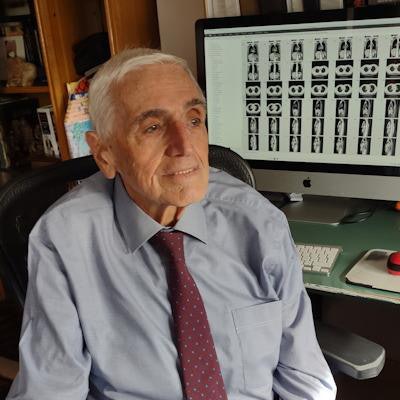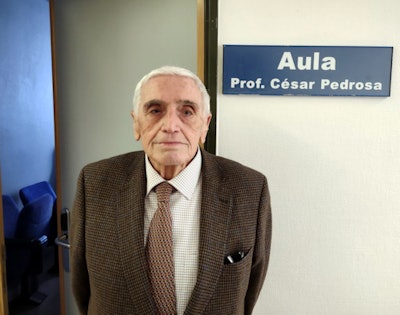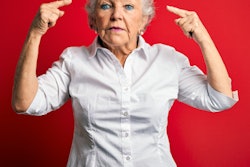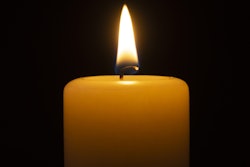
Approaching his 90th birthday, Dr. Cesar Pedrosa still sets an enviable pace. He gives a formal lecture on chest radiology every Wednesday to trainees at San Carlos Hospital, part of Complutense University of Madrid, where he has an office and is an emeritus professor. And he walks there regularly to pick up cases -- a 10-minute stroll from his home in the northwest of the city.
"I decided, when I retired, SSD -- shave, shower, dress -- then out, go and do something," he told AuntMinnieEurope.com in an interview.
 "Shave, shower, dress -- then out." This philosophy has served Pedrosa well.
"Shave, shower, dress -- then out." This philosophy has served Pedrosa well.Many who hang on the opinions of the renowned professor emeritus and former president of the Spanish Society of Medical Radiology (SERAM) are grateful that he still adopts this approach.
Pedrosa, a veteran of some 600-plus radiology conferences and writer/editor of seminal textbooks, actually "retired" in 2002 but continues to flourish and has retained popularity and esteem. He was still working when we caught up with him earlier in January via Zoom: preparing a special lecture for his students ("The silhouette sign revisited") and a course on the mediastinum for SERAM's website.
Thoughts on the pandemic and AI
He still has plenty to say on key professional issues, such as how training might change in light of the COVID-19 pandemic and where new technologies may lead, and he is very active online. The pandemic took a desperately heavy toll in Spain, particularly in early 2020.
 Pedrosa was born only nine years after Wilhelm Conrad Roentgen died, but he remains a prolific writer, teacher, and computer user.
Pedrosa was born only nine years after Wilhelm Conrad Roentgen died, but he remains a prolific writer, teacher, and computer user."COVID was such an explosion, it was terrible, there were many people dying in the first few months in Spain," he said, adding that radiologists performed well in the circumstances, responding to the needs of hospitals, as they were dispatched to care for patients in emergency departments in the first wave.
Pedrosa wrote an editorial for the July/August 2020 edition of Radiología, entitled "¿Estamos preparados? (Are we ready?)." In his editorial, he defended the "necessity" of clinical training prior to radiological training. He also weighed in on concerns that radiologists who had not read chest x-rays for years could struggle with the complexity of interpreting early lesions.
"The difference between cases with pneumonia and without pneumonia is quite important in Covid, but you need somebody who can tell you, 'Yes there is some pneumonia here,' but it's not easy," he told AuntminnieEurope.com. "Ground-glass lesions are very difficult to see on a chest x-ray, sometimes you don't see at all. I don't think continuing education is well established and organised in Spain, that's a failure."
Hence, his desire to ensure radiologists regularly refresh their skills. With the threat from COVID-19 rising, Pedrosa was in Asturias, the northerly region of his birth, with his wife for six months from March to October 2020. But he stayed in contact with fellow radiologists. He delivered an online chest course, "15 hours with Pedrosa" to Sociedad Veracruzana de Radiología (Mexico), and in September 2021, he gave a lecture on pneumonias to the annual meeting of the Venezuela Radiological Society.
 Pedrosa still gives formal lectures to trainees at San Carlos Hospital.
Pedrosa still gives formal lectures to trainees at San Carlos Hospital.As a self-declared optimist who has witnessed momentous changes over the years in his profession, Pedrosa is hopeful about radiology's future.
He is confident that artificial intelligence (AI) "will improve the role of radiologists," although he admits modestly it is "well beyond my capacity of understanding and learning."
By standardizing chest x-ray reading, AI could within years make chest x-ray readings by nonexpert radiologists as reliable as those by expert radiologists, he has noted. But it won't replace them, he insists.
The early years
Pedrosa was a leading figure in the 1960s in the establishment of national training for radiologists in Spain at a time when ignorance of important matters such as radiation protection was lacking. He was a member of the Education Commission responsible for the implementation of the MIR Programme (1963-1970). It followed his return from the U.S., a period of "discovery" for him, which included a residency in diagnostic radiology at Jefferson Medical College, Philadelphia.
 The young Cesar Pedrosa as a trainee in 1956.
The young Cesar Pedrosa as a trainee in 1956."I went to the U.S. in 1958, almost 20 years before Franco died. It was a tremendous shock -- the way of life, the politics -- and it opened up my mind quite a bit," he said. I came back to Spain, probably besides being a radiologist, also being a democrat."
From 1963, Pedrosa was working in Oviedo, alongside several U.S.-trained colleagues.
"By the summer we had written a manual on a formal programme of training for interns and residents, like in the US with a rotating internship and the formal training in specialties. We had a national offer by September. From 1965 our system was adopted by the majority of hospitals in Spain and it definitely changed medical training," he said.
He has said since the MIR system still ensures high-quality specialized training, "warts and all," but he observed how it has suffered from "inertia," lack of investment and lax accreditation of centers and hospitals "where residents are used as cheap labour."
In the recent editorial, he said the radiology curriculum would have to adapt to a new era, not just new technologies, with more interactive learning, particularly distance learning.
Pedrosa has, in one sense, seen it all before, living through convulsive developments in the specialty.
"CT was a revolution -- the chest has been the response to many problems." The impact on teaching and diagnosing disease has been "tremendous," he said, noting how in the mid-1970s, he convinced a government minister to approve installing one of the most expensive CT scanners at the University Hospital of Madrid, which was at the time strapped for cash and not covered by the social security system. One year later he met the minister again.
"His mother had a stroke and needed a CT scanner," he recalls. "I showed him our machine and asked him, 'Remember our fight for this machine?' 'Yes of course,' he answered. 'Well,' I said, 'none of the other machines offered in the tender are today in the market.' "
Then there was the excitement of traveling to London to see the EMI scanner at Northwick Park Hospital and seeing an MRI machine for the first time at the Siemens company in Nuremburg. "It was installed in a wood cabin, they kept it there because of the iron and steel in the buildings and so forth, they were a little bit concerned about that."
He cites two other key developments -- radiotherapy and diagnostics becoming two different medical specialties and the move, as yet incomplete, toward university-level professorships in diagnosis. And he is quick to add two more -- the development of SERAM into a "well-known, serious society with scientific goals in training and medical education" and the welcome development of "open access to medical information."
Personal highlights
As for his own achievements, Pedrosa is particularly proud of the two-volume textbook on Diagnostic Imaging that he wrote and edited in 1985 -- a second edition, in six volumes appeared in 1991 and a compendium was also published. Other special moments include receiving the Medaille "Antoine Beclere" of the International Society of Radiology.
Pedrosa, who was born in 1932, shortly before the Spanish Civil War, saw his country transformed as democracy took hold following the death of the dictator General Franco in 1975 -- "when he died, it was like a big explosion of joy," he says.
Cesar Pedrosa's Timeline:
1932 -- Born on 25 February in Ribadesella (Asturias)
1963-1970 -- Head of Radiodiagnosis service, Asturias General Hospital
1970-2002 -- Head of Radiodiagnosis Department, Clinic Hospital, Madrid
2002 -- Emeritus Professor of Radiology, Universidad Complutense, Madrid
Medalla de Oro de la Sociedad Española de Radiología
1977-1981 -- President of SERAM
Books:
Diagnóstico por la Imagen. Editorial McGraw-Hill. 1ª edición. 1986
Diagnóstico por la Imagen. 2ª Edición Editorial McGraw-Hill. 1999-2002
Diagnóstico por la Imagen Compendio. Editorial McGraw-Hill. 1987
Monografias "Diagnostico por Imagen." Madrid, 1987
Given that health systems everywhere are facing huge pressures, he says the "mechanics" of the Spanish system and availability of services such as vaccines have held up well.
He plans to celebrate his 90th birthday in February 2022 with family "if the pandemic allows us to meet," saying they are "always there when needed."
One of his four sons, Ivan Pedrosa, followed him into medicine -- he is a professor of radiology at the University of Texas -- and he has a daughter and six grandchildren.
He has said in the past that transmitting knowledge that has cost so much to learn is a "matter of generosity."
What advice does he have for today's radiology trainees?
"Medicine requires a lot of common sense (in Spain we say, the least common of the senses). Use it," he said. "My first teacher used to tell me, 'The day you would know more medicine would be the day when you finished your training.' Don't waste your time."



















